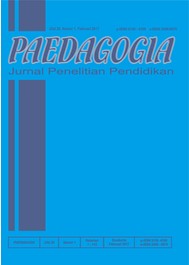The Development of Komfun CT Learning Media Based on Scratch to Enhance Computational Thinking Skills
Abstract
This research is motivated by the low level of students' computational thinking skills in mathematics learning, particularly in the topic of function composition. To address this issue, a Scratch-based learning media was developed with the aim of helping students understand the concept of function composition while also enhancing their computational thinking skills. The aim of this study is to produce Komfun CT learning media based on Scratch for function composition material. The research was conducted in the 2024/2025 academic year using the Research & Development (R&D) method based on the ADDIE model, which consists of five stages: Analysis, Design, Development, Implementation, and Evaluation. The quality of the developed media must meet the criteria of validity, practicality, and effectiveness. The instruments used in this study include observation sheets, interview guidelines, questionnaires, and tests. The observation sheets were used to obtain information about mathematics learning activities conducted by the teacher at school. The interview guidelines were used with students to collect qualitative data regarding the practicality of the developed media. The questionnaires consisted of a student response questionnaire, a material expert questionnaire, and a media expert questionnaire. Finally, the computational thinking test, which included a pre-test and post-test, was used to assess students’ computational thinking skills before and after using the media.The results showed that: (1) the media developed using the ADDIE model successfully produced Komfun CT learning media based on Scratch; (2) the Komfun CT learning media was declared feasible based on expert validation (material and media), covering aspects of validity, practicality, and effectiveness; (3) the developed media met the validity criteria with an average percentage of 93.86%. The practicality test results showed an average percentage of 83.60% from student responses. The effectiveness test based on N-Gain analysis showed an average gain score of 85.43%, indicating that the media is effective in enhancing students’ Computational Thinking.
Keywords
Full Text:
PDFReferences
Aulia, S. (2021). Development of interactive multimedia-based learning media using Scratch with a computational thinking method on trigonometry material in Grade X at SMA Negeri 7 Mandau (Doctoral dissertation, Universitas Islam Riau).
Brown, H. D. (2006). Language assessment: Principles and classroom practices. Pearson Education, Inc.
Dewi, A. N., Juliyanto, E., & Rahayu, R. (2021). The effect of science learning with a computational thinking approach assisted by Scratch on problem-solving ability. Indonesian Journal of Natural Science Education, 4(2), 492–497.
Hadi, M., Atiqoh, K., & K., K. (2021). Improving students' mathematical computational thinking using Scratch program through project-based learning: A development research during pandemic COVID-19. In 2021 9th International Conference on Cyber and IT Service Management (CITSM) (pp. 1–5). IEEE. https://doi.org/10.1109/CITSM52892.2021.9588856
Hake, R. R. (1998). Interactive-engagement vs. traditional methods: A six-thousand-student survey of mechanics test data for introductory physics courses. American Journal of Physics, 66(1), 64–74. https://doi.org/10.1119/1.18809
Jun, S., Han, S., & Kim, S. (2017). Effect of design-based learning on improving computational thinking. Behaviour & Information Technology, 36, 43–53. https://doi.org/10.1080/0144929X.2016.1188415
Kadir, A., & Suryantoro, F. S. (2016). Scratch for Arduino (S4A): Panduan untuk mempelajari elektronik dan pemrograman.
Kwon, K., Jeon, M., Guo, M., Yan, G., Kim, J., Ottenbreit-Leftwich, A., & Brush, T. (2021). Computational thinking practices: Lessons learned from a problem-based curriculum in primary education. Journal of Research on Technology in Education, 55, 590–607. https://doi.org/10.1080/15391523.2021.2014372
Maharani, P. P., Juandi, D., & Nurlaelah, E. (2024). Analysis of junior high school students’ computational thinking ability in solving mathematical problems in terms of mathematical habits of mind. SIGMA DIDAKTIKA: Journal of Mathematics Education, 12(1), 1–20.
Manik, H., Sihite, A. C. B., Manao, M. M., Sitepu, S., & Naibaho, T. (2022). The theory of humanistic philosophy in mathematics learning. Edumaspul: Journal of Education, 6(1), 348–355. https://doi.org/10.33487/edumaspul.v6i1.3037
Mardiyanto, H. (2018). Development of Komfun CT learning media in science subjects for Grade V on water conservation material [Bachelor’s thesis, Universitas Sanata Dharma Yogyakarta]. http://repository.radenintan.ac.id/20523/
Motu, C. I. (2024). Development of Scratch-based mathematics learning media to improve students’ computational thinking skills [Undergraduate thesis, Universitas Katolik Widya Mandira Kupang]. http://repository.unwira.ac.id/id/eprint/14900
Pou, A., Canaleta, X., & Fonseca, D. (2022). Computational thinking and educational robotics integrated into project-based learning. Sensors (Basel, Switzerland), 22(10), Article 3746. https://doi.org/10.3390/s22103746
Pramesti, P., & Ferdianto, F. (2021). An analysis of students' difficulties in learning mathematics on the topics of function composition and inverse function in Grade X at SMA Negeri 1 Rajagaluh. Journal of Mathematics and Science Education, 7(2), 74–79.
Rayanto, Y. H. (2020). Developmental research with the ADDIE and R2D2 models: Theory & practice. Lembaga Academic & Research Institute.
Sugiyono. (2017). Quantitative, qualitative, and R&D research methods. Alfabeta.
Vhalery, R., Setyastanto, A. M., & Leksono, A. W. (2022). Independent learning and Kampus Merdeka curriculum: A literature review. Research and Development Journal of Education, 8(1), 185. https://doi.org/10.30998/rdje.v8i1.11718
Wing, J. M. (2006). Computational thinking. Communications of the ACM, 49(3), 33–35.
Yulianisa, A., & Sudihartinih, E. (2022). Development of Scratch-based mathematics learning media on algebraic multiplication materials. Journal of Mathematics Education, University of Lampung, 10(2), 142–156.








